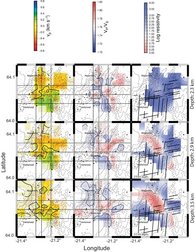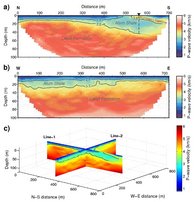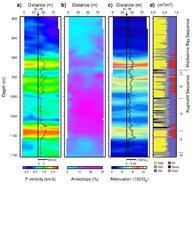WG Applied Seismics
Active and passive seismic methods are used in our group to study unconventional reservoirs (gas hydrates, gas shales, geothermal). The exploration of such resources requires knowledge of the seismic properties. We carried out crosshole tomography in gas hydrates and found unusual seismic characteristics. Gas shales are studied using core analysis, near-surface tomography, and seismic reflection processing. Geothermal exploration projects were carried out in the Central European basin and in Island. A new project started now to develop geothermal energy in Indonesia.
Major topics to be addressed in geothermal exploration include (1) the general geological structure (litho-stratigraphy), (2) information on the temperature field, (3) the location of faults as major fluid pathways, and (4) the distribution of fluids. Seismic methods provide information to these questions and are used together with other disciplines to determine optimal sites for the utilization of geothermal energy. In several geothermal projects we apply seismic reflection and seismic refraction methods, combined seismic and thermal modelling, joint interpretation of seismic and magnetotelluric data, and seismological techniques.
Projects: Gross Schoenebeck, I-GET, Polish basin, Alberta basin, Island, Indonesia
Publications: Bauer et al. (2010, 2012) Jousset et al. (2011), Muksin et al. (2013a, 2013b, 2014), Pussak et al. (2014)
Gas-bearing black shales are found wide-spread in the North American Southern Permian basin. A new project initiative was established at GFZ to evaluate the potential resources of gas shales in Europe. We investigate a wide spectrum of seismic properties of gas shales at different scales (core analysis, near-surface geophysics, 3D seismic reflection data). Particularly, we are interested in properties like attenuation and anisotropy. This research is undertaken to determine seismic characteristics which are diagnostic for gas shale anomalies.
Projects: GASH
Publications: Baumann-Wilke et al. (2012)
Gas hydrates are ice-like substances formed by open cages of water molecules which surround methane or other gas molecules. They are considered as potential future energy resources, and as important factors in climate change scenarios. Seismic methods are required to map the distribution and to monitor changes of gas hydrate formations. We study seismic properties of gas hydrates in-situ (crosshole tomography), and by laboratory experiments (planned).
Projects: Mallik, LARS
Publications: Bauer et al. (2008, 2015)





